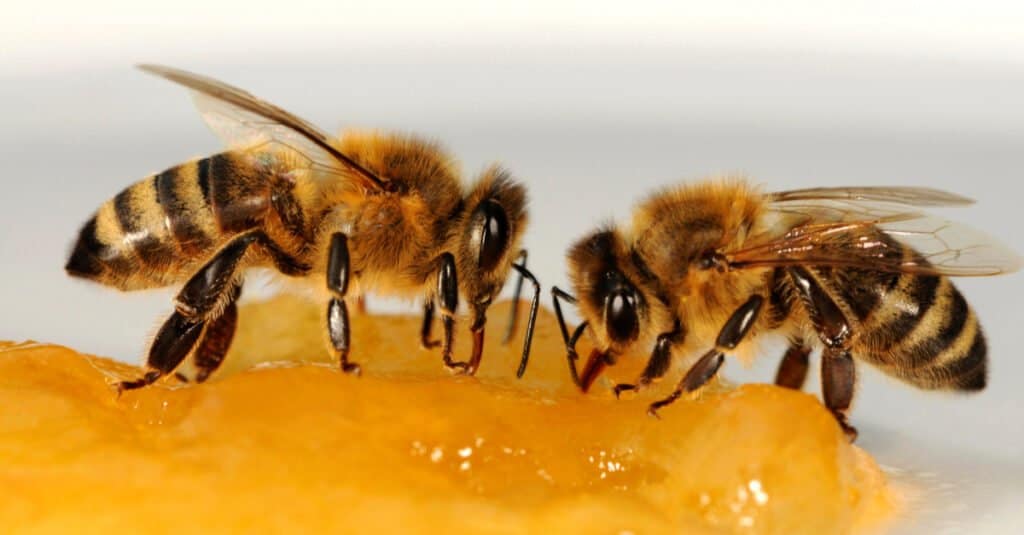Bees are one of the most recognizable insects for many reasons, from their black and yellow-striped bodies to their role in global pollination. Bees are most active during spring and summer, so they must switch to an alternative diet during the harsh winter when their favorite food sources become scarce. Let’s explore what bees eat in winter and how their colonies prepare food to survive the cold weather.
What Does a Bee Eat Most of the Year?
Most of the year, bees eat pollen and nectar. Pollen is a bee’s primary source of protein throughout the spring and summer, providing plenty of vitamins and minerals. Adult bees and bee broods enjoy eating pollen equally. Nectar is a bee’s primary source of carbohydrates that they convert into energy for flying and performing daily tasks.
Another food that some bees indulge in is fruit. For example, honey bees might eat ripe apples, peaches, and plums if they come across them. If something tastes sweet, you can expect a bee to like it.
A Bee’s Winter Diet

Bees feast on the honey they produce from the nectar they collect as their primary winter food source.
©schubbel/Shutterstock.com
Honey is a sticky, sweet substance that bees eat once winter arrives. It’s one of the few foods in this world that doesn’t spoil, allowing bees to store and consume it for months. Bees usually have more honey to access when humans don’t extract too much from the hive.
When bee clusters consume honey in the winter, it gives them energy to use their flight muscles to create heat to keep them warm.
How Do Bees Know When to Start Changing Their Diet?
Several factors in the leading months before winter help a bee colony’s workforce prepare to transition to a new diet to ensure survival. Here are a few noteworthy examples.
Dropping Temperatures
Bees prefer flying when outdoor temperatures are at least 55° F. Bees’ bodies help them predict the weather because of their sensitivity to temperature and barometric pressure changes. As temperatures drop in late summer and early fall, they spend more time preparing the hive for winter. Sudden cold snaps in autumn can impact a bee colony’s survival rate if the pack is unprepared.
Shorter Daylight Hours
During the summer, bees are most active during the daytime. As winter approaches, daylight hours begin to get shorter. Bees must use these limited daylight hours to collect enough food to feed the colony.
Flowers Stop Blooming
When the colorful flowers that worker bees gather nectar from stop blooming, it indicates that their standard food sources are dormant until spring.
How Do Bees Prepare Their Food for Winter?

Honeycombs get filled to the brim with honey to help bee colonies survive the winter.
©stockcreations/Shutterstock.com
Since bees can’t produce new honey in winter, they need to collect nectar in advance throughout spring and summer. As they gather nectar from flowers and return to the hive, they seal it with a thin wax in honeycombs. These sealed honeycombs are a storage reserve for honey that sustains bees throughout the winter.
The amount of honey bees consume during the winter depends on how much honey they produce and the colony’s size. Most bees try to preserve their honey, but if bees don’t collect enough nectar for consistent honey production, they won’t have enough food to survive the winter.
Do All Bees Eat Honey During Winter?
It’s easy to assume that all bees produce honey. However, some bee species, like carpenter bees, don’t make or eat honey to use during the winter. Instead, they rely on the pollen they store in their tunnels for wintertime nourishment.
Bees are like nature’s rock stars with their cool black and yellow outfits and that whole pollination gig. But when winter hits, they go through a total menu makeover. Most of the year, they’re all about pollen and nectar – protein and energy. But when it gets chilly, they switch to honey, that golden, sticky goodness they’ve been saving since summer.
This shift in their diet isn’t just random; it’s because of nature’s cues. Bees are smart cookies. When temperatures drop, daylight hours shrink and flowers stop partying with blooms, bees know it’s time to break out the honey stash and hunker down.
This adaptation shows us just how unique and resourceful these little guys are. They have this intricate relationship with their environment that keeps them going, and it’s crucial for our ecosystems and agriculture.
So, next time you see a bee buzzing around, remember they’re not just cool-looking bugs; they’re the unsung heroes of the natural world, and we’ve got to do our part to look out for them.
The photo featured at the top of this post is © Goncharov Taras/Shutterstock.com
Thank you for reading! Have some feedback for us? Contact the AZ Animals editorial team.







